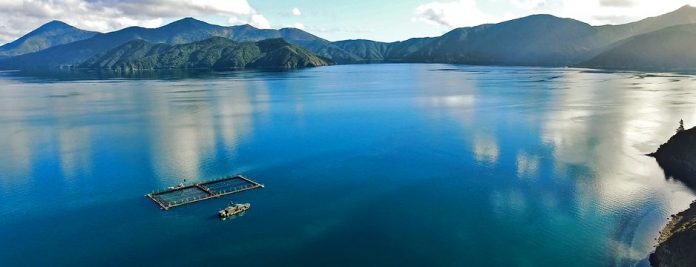The New Zealanders are braced for ‘disappointing’ fish farm relocation.
According to BusinessDesk, New Zealand King Salmon says it hopes it will be allowed to move around half of nine square hectares of its Marlborough Sounds fish farms to better locations. However it is braced for a “disappointing” outcome.

The Ministry for Primary Industries announced a proposal in to move six salmon farms in the Marlborough Sounds from low flow to higher flow sites in January 2017. The proposal aims to reduce environmental impact, mitigate summer temperatures, create even more green jobs, and prepare for the future of salmon farming.
- Read more: New Zealand King Salmon CEO: “We believe that aquaculture is literally going to save the world”
Relocation
Fisheries Minister Stuart Nash is expected to take recommendations on the proposed relocations to Cabinet before Christmas, with a decision pencilled for February. Nash said the newly created Fisheries New Zealand agency, split out from the Ministry for Primary Industries, would deliver a new aquaculture strategy within the next year and strongly backed emerging deep-sea fish farming technology.

NZKS chief executive, Grant Rosewarne, made the comments at the Aquaculture New Zealand conference telling the publication that he had expressed frustration at the likelihood of a “sub-optimal outcome”.
Leaving 4.5 hectares of the nine hectares of existing farms in place would be worse for both productivity and the environment “when we can get a world’s best practice environmental outcome a kilometre away,” he said.
Rosewarne said NZKS was already producing “the most highly branded salmon in the world, with highly differentiated products. We’re getting high prices” but slow bureaucracy surrounding the proposal was affecting future growth.
Proper strategy
“I do think we will get there and you heard the positive intent of the minister,” Rosewarne added but had expressed frustration at that the proposal had not been “given a fast track or enabled with a proper strategy.”
Rosewarne added that barely 20 surface hectares was licensed for salmon farming in New Zealand saying that “17 hectares of which are ours, and half of which is no good”.
Furthermore moving the whole nine surface hectares in question “should not be a hard thing”, he said.
“We can’t even move a tiny nine surface hectares, which we’ve already got and can already use, to a better spot and get a vastly superior outcome. That’s really disappointing.”
Deep sea
Part of the relocation is looking ahead toward the company’s long terms strategy towards offshore farming in deeper, less sheltered, high energy surface waters with stronger currents. Earlier this month SalmonBusiness reported that the company is researching its first steps to using submersible tech to farm salmon in the Cook Strait lies in the North and South Islands of New Zealand.
“We could be New Zealand’s most valuable industry bar none – technology, dairy, education, tourism. We can outdo all of those if there’s a proper industry strategy and we can do it with an environmental footprint that would be hard to measure, it would be so green” Rosewarne added.

